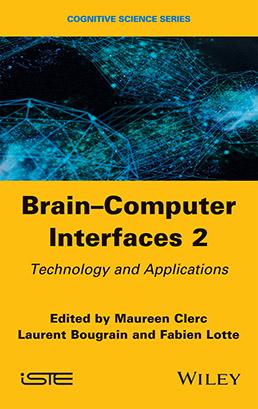
Brain–computer interfaces (BCI) are devices which measure brain activity and translate it into messages or commands, thereby opening up many possibilities for investigation and application. This book provides keys for understanding and designing these multi-disciplinary interfaces, which require many fields of expertise such as neuroscience, statistics, informatics and psychology.
This second volume, Technology and Applications, is focused on the field of BCI from the perspective of its end users, such as those with disabilities to practitioners. Covering clinical applications and the field of video games, the book then goes on to explore user needs which drive the design and development of BCI. The software used for their design, primarily OpenViBE, is explained step by step, before a discussion on the use of BCI from ethical, philosophical and social perspectives.
The basic notions developed in this reference book are intended to be accessible to all readers interested in BCI, whatever their background. More advanced material is also offered, for readers who want to expand their knowledge in disciplinary fields underlying BCI.
Part 1. Fields of Application.
1. Brain–Computer Interfaces in Disorders of Consciousness, Jérémie Mattout, Jacques Luauté, Julien Jung and Dominique Morlet.
2. Medical Applications: Neuroprostheses and Neurorehabilitation, Laurent Bougrain.
3. Medical Applications of BCIs for Patient Communication, François Cabestaing and Louis Mayaud.
4. BrainTV: Revealing the Neural Bases of Human Cognition in Real Time, Jean-Philippe Lachaux.
5. BCIs and Video Games: State of the Art with the OpenViBE2 Project, Anatole Lécuyer.
Part 2. Practical Aspects of BCI Implementation.
6. Analysis of Patient Need for Brain–Computer Interfaces, Louis Mayaud, Salvador Cabanilles and Eric Azabou.
7. Sensors: Theory and Innovation, Jean-Michel Badier, Thomas Lonjaret and Pierre Leleux.
8. Technical Requirements for High-quality EEG Acquisition, Emmanuel Maby.
9. Practical Guide to Performing an EEG Experiment, Emmanuel Maby.
Part 3. Step by Step Guide to BCI Design with OpenViBE.
10. OpenViBE and Other BCI Software Platforms, Jussi Lindgren and Anatole Lecuyer.
11. Illustration of Electrophysiological Phenomena with OpenViBE Fabien Lotte and Alison Cellard.
12. Classification of Brain Signals with OpenViBE, Laurent Bougrain and Guillaume Serrière.
13. OpenViBE Illustration of a P300 Virtual Keyboard, Nathanaël Foy, Théodore Papadopoulo and Maureen Clerc.
14. Recreational Applications of OpenViBE: Brain Invaders and Use-the-Force, Anton Andreev, Alexandre Barachant, Fabien Lotte and Marco Congedo.
Part 4. Societal Challenges and Perspectives.
15. Ethical Reflections on Brain–Computer Interfaces, Florent Bocquelet, Gaëlle Piret, Nicolas Aumonier and Blaise Yvert.
16. Acceptance of Brain–machine Hybrids: How is Their Brain Perceived In Vivo? Bernard Andrieu.
17.Conclusion and Perspectives, Maureen Clerc, Laurent Bougrain and Fabien Lotte.
Maureen Clerc is Senior Researcher at Inria Sophia Antipolis, France.
Laurent Bougrain is Associate Professor at the University of Lorraine, France.
Fabien Lotte is Junior Researcher at Inria Bordeaux, France.